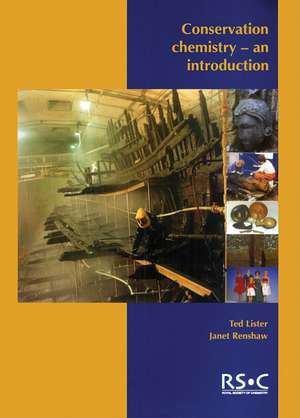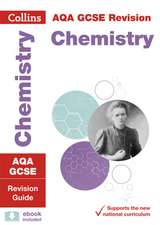Conservation Chemistry
Autor Ted Listeren Limba Engleză Paperback – 31 dec 2004
The chemical sciences and their applications are all around us. Many museums and galleries have scientific departments, and collectors of objects that may not even be "antique" in the strict definition of the word often need to have some scientific knowledge to stop their collection deteriorating. This resource shows how chemical techniques are used in conserving objects made from a wide variety of materials and seeks to introduce some of the ethical considerations of conservation to students. It is hoped that this will encourage teachers and students to consider the chemical sciences in their widest context and to reinforce the beneficial aspects of chemistry in unlikely contexts.
Preț: 191.03 lei
Nou
Puncte Express: 287
Preț estimativ în valută:
36.55€ • 38.17$ • 30.18£
36.55€ • 38.17$ • 30.18£
Carte disponibilă
Livrare economică 25 martie-08 aprilie
Preluare comenzi: 021 569.72.76
Specificații
ISBN-13: 9780854043958
ISBN-10: 0854043950
Pagini: 114
Ilustrații: col. Illustrations
Dimensiuni: 208 x 290 x 8 mm
Greutate: 0.36 kg
Editura: Royal Society Of Chemistry
ISBN-10: 0854043950
Pagini: 114
Ilustrații: col. Illustrations
Dimensiuni: 208 x 290 x 8 mm
Greutate: 0.36 kg
Editura: Royal Society Of Chemistry
Cuprins
Plastics conservation; Stone conservation; Wood conservation
Recenzii
It is a well produced teaching resource from the RSC... This is a facinating subject and is brought to life expertly; the students' notes are clear and well written and there are some good ecperiemental ideas and exercies too. It is well worth consideration by the teachers as part of a GCSE science sourse and a good deal of it would be suitable to augment AS ana A level chemistry too. ..a fine set of materials which this reviewer very much enjoyed and would highly recommend.
Textul de pe ultima copertă
This book is divided into three sections, dealing with the conservation of plastics, stone and wood. It provides teaching and learning materials that deal with familiar chemistry in an unfamiliar context. it also helps to show how the chemical sciences play a part in many unexpected areas of life. Many people think of objects made of plastic as 'throwaway' and do not consider them as collectable items or ones that might be found in museums. In fact there are increasing numbers of plastic objects in museums as well as in private collections and many are increasing in value. To give just one example, some Barbi (TM) dolls can change hands for thousands of pounds. it is also a misconception that plastics do not decay easily - many of them do, and this raises issues about how best to preserve them. This section is set in a context of the collection, care, identification and display of objects in museums and by private collectors. The section on stone focuses on a case study. In order to prevent damage to a stone object, conservation scientists sometiems surround the object with filter paper soaked in pure water. This is called poulticing. Conservation scientists at the British Museum wanted to investigate the poulticing process to see how effective it was at removing salts and to find out whether previous treatment of the stone affected the efficiency of the removal process. The section on wood focuses on the Mary Rose, a wooden Tudor warship that sank off Portsmouth in 1545. In 1982, the hull was raised and since then has been undergoing conservation treatment in a former dry dock at Portsmouth. Over 19,000 artefacts were recovered. The material processed here looks at the chemistry of the decay processes and the methods used to conserve the wood of the Mary Rose's hull and some of the other materials involved.
Descriere
This text hopes to encourage teachers/students to consider the chemical sciences in their widest context and to reinforce the beneficial aspects of chemistry in unlikely contexts.














